Physical Address
304 North Cardinal St.
Dorchester Center, MA 02124
Burn injuries to the trunk may have functional and cosmetic consequences.
The torso, abdomen, and back connect anatomically with the shoulder girdle and the axilla laterally, with the neck superiorly, and with the groin tissue and the lower limbs inferiorly. This means that burn injuries to the trunk may cause damage primarily to three areas:
Damage to soft tissue layers including skin, subcutaneous tissue, fascia, muscle, and internal organs
Damage to the trunk boundaries, causing potential contracture and functional deficit to the neck, axillae, and groin areas
Damage to specialized body parts within the trunk, specifically the breast.
Even though the initial acute management of any extensive burn injury is relatively universal and subjected to well-recognized protocols of trauma resuscitation, the extensive total body surface area (TBSA) that can potentially be involved when the whole of the trunk is injured—up to 36% TBSA—may have devastating consequences: skin, muscle and visceral damage, breast and nipple-areolar destruction, and potential development of life-changing burn scar contractures in the vicinity of the neck, axillae, and groin areas.
It is then easy to understand the potential complexity of the reconstructive challenges that trunk tissue damage may require. Superficial damage may leave minimal functional deficit and barely noticeable cosmetic embarrassment that may not need difficult or lengthy reconstruction, but deeper damage may require the use of multiple reconstructive procedures of ascending order of complexity in several subzones of the trunk: excision of scars, use of split-skin grafts (SSG) with or without the support of dermal matrices, full-thickness grafts, tissue rearrangement procedures based on the z-plasty principle, tissue expansion surgery, and local, regional, distant, or free flaps.
Complex reconstruction will require maximum complicity and collaboration of the burn patient with the multidisciplinary team, specifically with the scar management and physical rehabilitation teams to ensure restoration of anatomy and return of the patient to his normal life and society environment.
The impact of appropriate acute management in subsequent reconstruction cannot be understated. The principles of prompt trauma management, judicious resuscitation, early débridement with a dermal preservation approach and soft tissue cover, and a strong rehabilitation approach impact greatly on the subsequent approach to reconstruction.
Any deep damage to the tissues of the trunk at those levels may cause simultaneously deep soft tissue loss, damage that affects body parts such as the breast, or a burn scar contracture either primarily or secondarily by involvement of those important joint mobile areas.
Recently published International Society for Burn Injuries (ISBI) practice guidelines for burn care supported by best evidence and research established recommendations for optimum acute management of the burn wound.
Those most relevant to successful reconstruction of the trunk are:
Thermally injured patients should be evaluated using a systematic approach that first seeks to identify the greatest threat to life.
Evaluation of burns should estimate TBSA utilizing a standardized method and delineate characteristics that require immediate attention from a designated burn center.
Appropriate resuscitation should be initiated promptly and tailored based on patient parameters to avoid over- and underresuscitation.
Adult patients with burns greater than 20% TBSA and pediatric patients with burns greater than 10% TBSA should be formally resuscitated with salt-containing fluids; requirements should be based on body weight and percentage burn.
Abdominal escharotomy should be performed when circumferential or near circumferential eschar is associated with evidence of intraabdominal hypertension (IAH) or signs of abdominal compartment syndrome (ACS).
Early surgery for small to moderate-sized deep burns (less than approximately 20% TBSA) speeds recovery, might improve outcome, and is cost-effective.
Tangential excision is the standard method of burn wound excision. Fascial excision may be indicated in very deep burns and high-voltage electrical conduction injuries.
Burn wound excision and grafting can be undertaken without undue blood loss by using some or all the following: subcutaneous infiltration of burn wound and donor site or topical application of epinephrine solutions, or both; tourniquets for limb surgery; fascial-type excision using electrocautery; other topical hemostatic agents such as thrombin and fibrinogen; prevention of hypothermia; compression dressings; limb elevation; and staged burn excision.
After excision or débridement of the deep burn wound, it is essential that the wound is covered with autograft skin or an appropriate skin substitute.
Deep dermal burns (wounds that heal in >3 weeks) require aggressive and monitored scar prevention therapies augmented with appropriate pain relief and combined with early positioning regimens and physiotherapy for joint mobilization to prevent hypertrophic scarring and joint contractures.
All extensive hypertrophic burn scars should receive pressure therapy with silicone therapy as the first line of treatment. Restraint should be applied in opting for the surgical modality before scar maturation unless the scar is functionally limiting because of a developing contracture.
Therefore, four clear burn care phases are ultimately considered:
Initial evaluation and resuscitation
Wound excision and initial skin cover
Definitive skin closure and rehabilitation
Reconstruction and reintegration to society.
Appropriate implementation of these recommendations in a staged fashion ensures the survivability of the burned patient, but also of the quality of the reconstruction.
Even though the late effects of burn injury in the tissue layers of the abdomen, torso, and back may be less problematic than in other anatomical areas, the consequences of abnormal scarring and tissue derangement may still cause functional problems such as pain, itching, limitations in activities of daily living, and cosmetic embarrassment.
The torso protects the thoracic cavity and upper abdomen and assists in the process of respiration. The abdominal wall, with its multilayered structure, protects the abdominal viscera and assists in position, breathing, and visceral function. The clinical consequences of the burn injury to this part of the trunk in an acute setting may be relatively mild or utterly devastating if full-thickness soft tissue loss occurs.
In the acute setting, superficial skin loss may be treated in a relatively conservative fashion with standard dressings or with the application of dermo-protective matrices such as Biobrane or Suprathel. A recent Cochrane review aiming to assess the effects of burn wound dressings on partial-thickness burns suggested that dressing selection should be based on their effects on healing but that other parameters such as ease of application and removal, dressing change requirements, cost, and patient comfort should also be considered. Their conclusion was that, following analysis of a total of 30 randomized controlled trials (RCTs), traditional dressings containing silver sulfadiazine (SSD) were consistently associated with poorer healing outcomes than were biosynthetic (skin substitute) dressings, silver-containing dressings, and silicon-coated dressings.
Dermo-protective skin substitutes are characteristically used to aid reepithelialization in the acute management of partial-thickness burns until full healing occurs. Biobrane is a bi-layered semi-permeable biosynthetic wound dressing with an outer silicone layer, a nylon-net in the middle layer, and an inner porcine collagen type I layer. Suprathel is a synthetic wound dressing consisting of a copolymer-foil of D,L-laktidtrimethylencarbonate and e-caprolakton.
A study comparing both dressings showed satisfying comparable clinical results in the use of both types of prosthetic material.
In the acute setting, extensive burns and injudicious fluid resuscitation may lead to ACS, defined by the presence of organ dysfunction because of increased abdominal pressure or IAH.
Patients with severe burns are at risk for developing ACS due to the large volume of resuscitation fluid that is infused, abdominal wall compliance, and capillary leakage due to increased permeability. This subsequently reduces blood flow to the abdominal viscera and may lead to bowel ischemia, multiorgan failure, and death if not properly addressed.
When decompressive laparotomy is necessary, the complications due to an open abdomen add to those due to the extent of the burn.
Decompressive laparotomy may help in the survival of burn patients, but the mortality can still be up to 50% and introduce a serious physiological and reconstructive challenge.
Recently updated consensus definitions and clinical practice guidelines from the World Society of the Abdominal Compartment Syndrome state that decompressive laparotomy is the standard surgical method to treat severe IAH/ACS despite considerable potential mortality even after decompression. Taking into consideration that the longer the abdomen remains open, the greater the potential complications, this forum of experts established several recommendations significant for the reconstructive strategies of the open abdomen following decompressive laparotomy for IAH:
Prevent visceral adhesions, loss of soft tissue coverage, lateralization of the abdominal musculature and its fascia, malnutrition, and enteric fistulae.
Aim to achieve same-hospital-stay closure of the open abdomen.
Consider the use of negative pressure wound therapy (NPWT) for temporary abdominal closure after decompressive laparotomy.
Consider component separation to facilitate early fascial closure of the open abdomen.
Bioprosthetic meshes should not be routinely used in the early closure of the open abdomen compared to alternative strategies.
Several temporizing options using external devices have been suggested to aid the closure of the abdomen following decompressive laparotomy.
The use of techniques that apply to the closure of large hernia defects can be used to close large decompressive laparotomy defects as well. The technique of component separation is not contraindicated in the burn patient, even in large burns with a deep pattern of injury.
In this series, fascial access was obtained by raising burned skin flaps at the level of the costal margin from the anterior superior iliac spine inferiorly to the ribs superiorly. These skin flaps were then excised to facilitate grafting of the abdominal wall. The fascial release that facilitated abdominal closure was made, in standard fashion, lateral to the rectus sheath through the aponeurosis of the external oblique muscle.
The acute reconstruction of trunk soft tissue loss related to the direct effects of the burn injury follows the steps applied to other parts of the body. Following stabilization, resuscitation, and débridement, acute soft tissue cover methods are decided based on the depth and extent of the burn, the availability of suitable donor sites, and the microbiology and nutritional status of the patient.
Extensive burns may destroy the skin layers and their blood supply to the extreme of making impossible self-healing and regeneration following a conservative approach. There are occasions in which the paucity of autologous skin or concerns regarding the infection control status of the recipient site recommends the use of temporizing techniques such as xenografts or allografts ( Fig. 52.1 ) until definitive skin cover is achieved. Characteristically split-thickness autografting has been the standard method to address soft tissue loss during this period. A recent expert panel white paper on the surgical management of the burn wound and use of skin substitutes clearly establishes the differences between skin substitute—a commercial biomaterial, engineered tissue, or combination of materials and cells or tissues that can be substituted for skin autograft or allograft in a clinical procedure—from a skin replacement, which is a tissue or graft that permanently replaces lost skin with healthy skin.
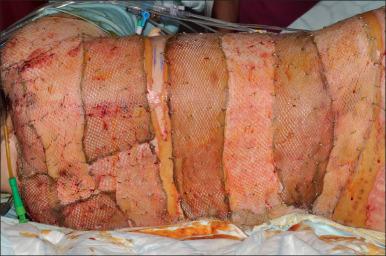
Skin grafts are usually meshed to a desired level of expansion; split-thickness grafts are frequently used if the wound bed exhibits appropriate vascularity and the donor skin is available in appropriate quantities. As every burns surgeon is aware, expansion of the SSG is associated with small areas of the wound healing by secondary intention and a poorer scar outcome.
In cases of extreme paucity of donor sites, the use of micrografting (Meek) techniques with or without dermal regeneration templates may represent a suitable form of reconstruction in the acute period ( Figs. 52.2 and 52.3 ).
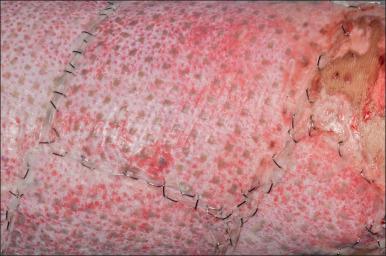
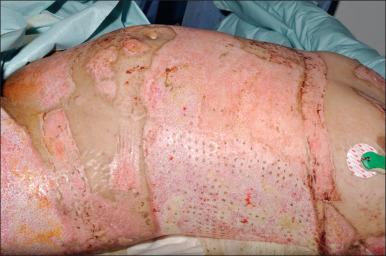
Tissue engineering options have expanded the possibilities of reconstruction for the burned trunk. The ideal tissue engineering device needs to be rapidly available, autologous, site-matched, possess reliable wound adherence and express minimal donor site morbidity, be clinically manageable, improve the quality of scar, and be affordable.
Some of the techniques currently available involve the use of dermal scaffolds such as Integra (Integra Life Sciences Corporation, Plainsboro, NJ), Matriderm (MedSkin Solutions, Dr. Suwelack, Germany), or Pelnac (Gunze Ltd., Japan) and the use of confluent and nonconfluent keratinocyte culture techniques such as Recell (Avita Medical, UK).
A deeper pattern of injury may require the use of more complex steps of the reconstructive ladder. The chest and abdomen, due to their anatomic proximity, are injured together frequently in flame, scald, or electrical injuries. In these situations, in which deep visceral structures may become exposed, the use of large flaps such as the omentum, latissimus dorsi, rectus abdominis, or deltopectoral may be indicated.
The late reconstruction of the soft tissue layers addresses the impact of abnormal scarring on the cosmetic and functional integrity of the trunk. Reconstruction due to scars in the boundaries of the trunk that alter the functionality of the neck, axillae, and groin area and reconstruction of specific body parts such as the breast will be addressed later in the chapter.
The reconstruction of the soft tissue layers of the trunk is simultaneous with recognized protocols of scar management such as massaging, moisturizing, and sun-protecting the scar; application of compression garments; and physical therapy. These are beyond the scope of this chapter and will not be addressed here.
The wise use of recognized surgical techniques in the acute phase of scar maturation diminishes the complexity of reconstructive needs. These include the use of darts in escharotomies when crossing joints, placing the seams of the skin grafts following skin tension lines, using sheet grafts when possible, placing grafts transversely over joints, applying early pressure therapy, and implementing an early ambulation and exercise regimen.
The skin layers of the trunk may be affected by abnormal pigmentation, hypervascularity, hypertrophic and keloid scars, texture abnormalities in both the reconstructed and the donor site ( Figs. 52.4 to 52.6 ), by the presence of contractures that can be well defined or diffuse, and by the presence of unstable tissue ( Figs. 52.7 and 52.8 ) with a tendency to breaking down. The approach to the management of these abnormalities is to always prioritize function over cosmesis, have a realistic approach to reconstruction, and appropriately time any surgical procedure to avoid interfering with the maturation of scars.
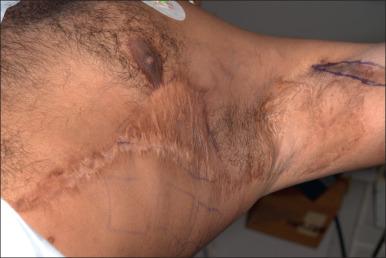
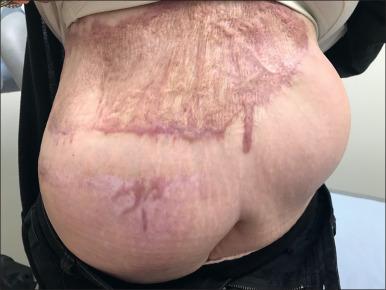
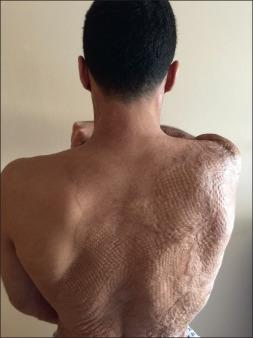
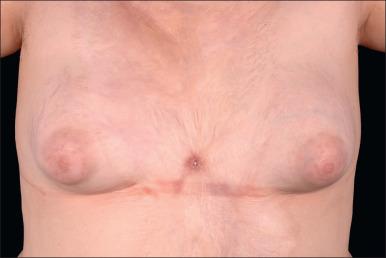
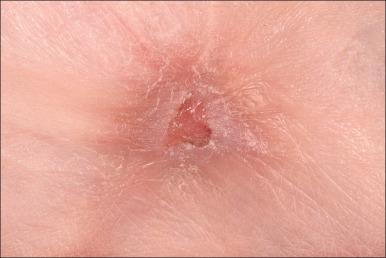
Selective scar resection and direct closure of the subsequent defect may be used in the trunk providing that sufficient skin laxity and tension-free closure exists.
The skin of the abdomen, with its natural laxity and the possibility of redundant tissue, allows the use of recognized techniques of reconstruction such as abdominoplasty and liposuction to become valid options of soft tissue cover after scar excision.
The use of full-thickness grafts or dermal regeneration templates constitutes the next stage in the resurfacing and reconstruction of elective scar revision surgery. They provide the patient with a reconstruction of improved pliability that has been proved to withstand even the natural skin tension resulting from a pregnancy.
In cases of cosmetically disfiguring scars that exhibit lack of pliability, the use of tissue expansion techniques either on their own or combined with flap techniques in the trunk offers the possibility of providing reconstruction with autologous skin following a two-stage procedure. The first stage introduces the expanders in a pocket near the scar. Once appropriate expansion has been achieved, including overexpansion, the scar is excised and the subsequent defect covered with a flap of expanded skin usually using a technique of advancement, transposition, or rotation. It has been postulated that the insertion of the largest possible expander, a rectangular shape, and the method of advancement provides the largest amount of expanded tissue available. Traditional tissue expanders are connected to a tubing system and a port that is placed usually over a bony prominence distant to the implant itself. Recently the use of osmotic tissue expanders has introduced a new option for reconstruction and resurfacing of defects after scar excision by avoiding the need for repeated injections. This is especially useful when dealing with pediatric patients.
The insertion of osmotic tissue expanders requires careful dissection of an appropriately sized pocket to place the prosthesis. This is an important issue in the learning curve of the early user of this technique because the osmotic tissue expander tends to grow relatively quickly during the first 2 weeks of insertion.
Insertion of the expander too close to the scar to be reconstructed will increase the potential for implant extrusion. A sequence for the insertion of osmotic tissue expanders can be seen in Figs. 52.9 to 52.14 . Following insertion, our protocol is to review the patient weekly for the first month post insertion to review the wound and assess for breakdown or dehiscence. We then follow the patient monthly until the second stage of reconstruction. This stage includes expander removal, scar excision, and reconstruction of the defect usually by advancement ( Figs. 52.15 to 52.18 ).
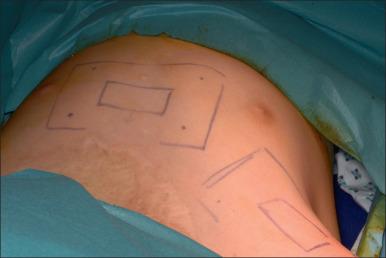
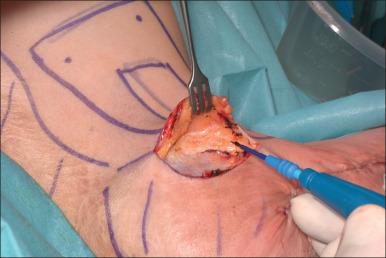
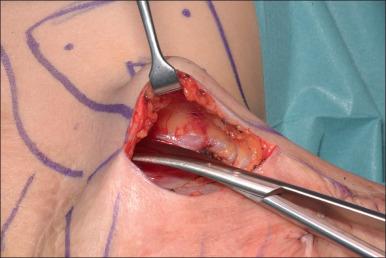
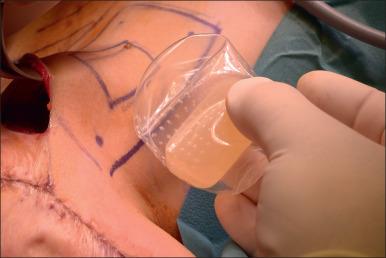
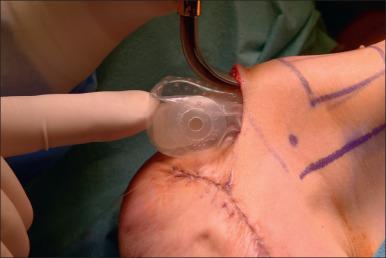
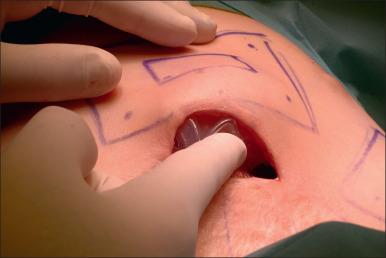
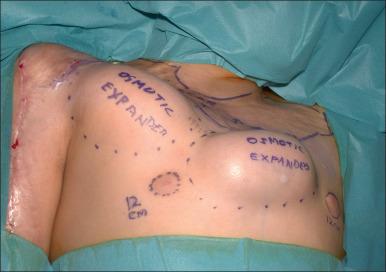

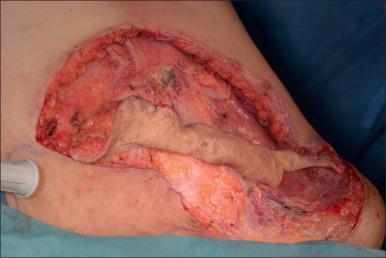
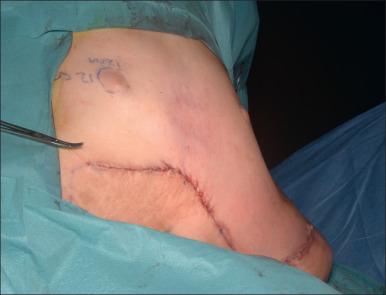
Become a Clinical Tree membership for Full access and enjoy Unlimited articles
If you are a member. Log in here